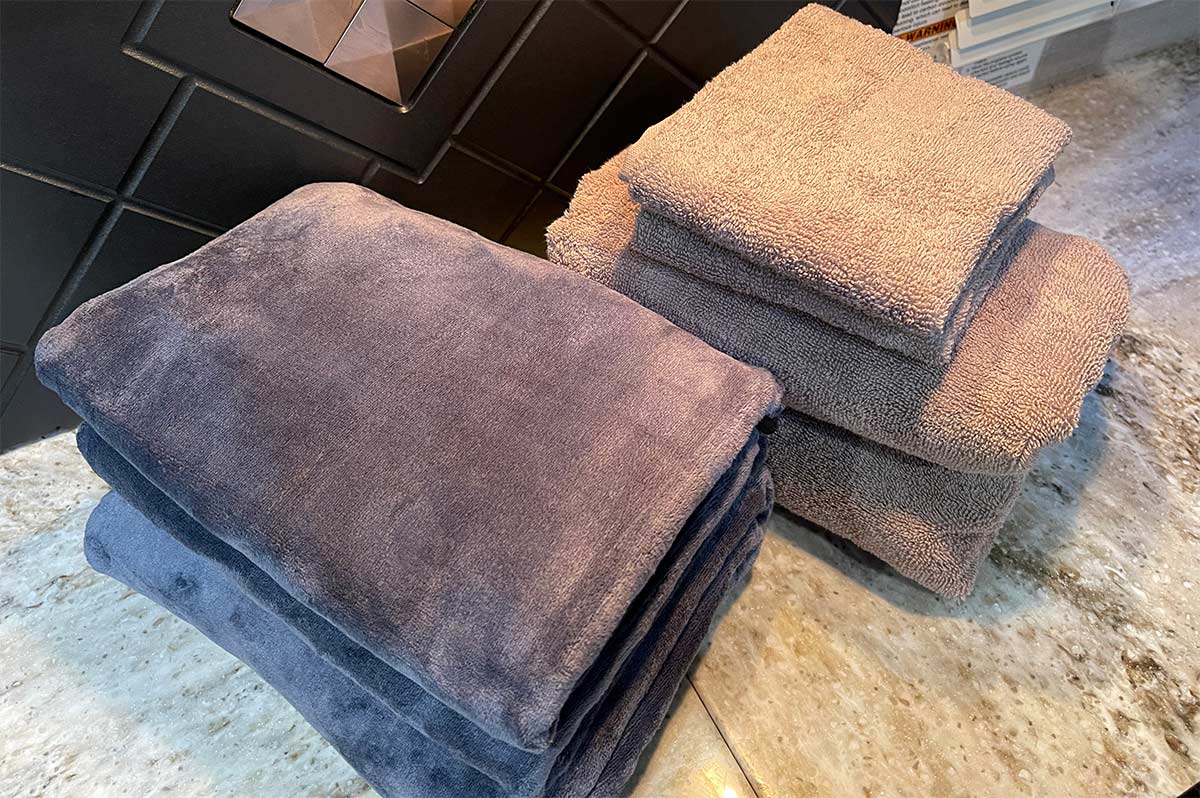Have you ever gotten out of a shower and reached for your towel only to find it was still wet from the day before? It’s a very unpleasant feeling that I’m sure most RVers have experienced at least once. Traditional cotton bath towels do not dry quickly, especially in humid climates. There is a simple solution that will solve the problem of having an eternally damp bath towel, make the switch from cotton to microfiber towels.
There are many benefits to using microfiber towels over cotton towels. Microfiber towels are lighter, more compact, and dry 3 times faster than cotton towels. They are also better at cleaning dust, dirt, and debris when compared to cotton.
After several months of using cotton bath towels in my RV, I decided to make the switch. I was tired of the eternally damp bath towel and wanted something that was easier to wash and dry in my rig. In this article, I’ll discuss both the benefits and downside of switching to microfiber bath towels. In my opinion, the benefits far outweigh the negatives.
Benefits of Microfiber
Microfiber towels are much better at cleaning
Microfiber towels are far superior when it comes to cleaning tasks. The incredibly small fibers lift and trap dirt, dust, and debris. The fibers in the towel carry a small static charge which helps attract lightweight particles like dust. They can be used both wet and dry and are highly effective when it comes to disinfecting surfaces when compared to cotton towels.
As it relates to bath towels, microfiber towels are much better at removing dead skin cells from your body. Cotton towels don’t lift or trap skin cells, they just sort of push them around on the surface of your skin.
Microfiber towels are lighter and more compact
As every RVer knows, space and weight are precious commodities. Microfiber towels are more compact and lighter than cotton towels. In many cases, you can fit 2 or 3 microfiber towels in the space 1 cotton towel would take, allowing you to carry more towels.
The typical medium cotton bath towel weighs about 1.5 lbs. A larger, oversized microfiber bath towel weighs about 1 lb. The lower weight and smaller form factor make packing and traveling with a microfiber towel a breeze. You can pack one up in your backpack and take it on a daytrip or use them at the beach.
Microfiber towels dry faster than cotton towels
Microfiber towels are highly absorbent but they also dry 3 times as fast as cotton towels. If you live or RV in a humid climate, you may have experienced the dreaded eternally wet bath towel. You jump out of a nice shower to be greeted by a damp towel that has been drying on a hook for the past 24 hours.
With microfiber, you don’t have that problem. It dries in a fraction of the time it takes a cotton towel to dry. You won’t need to use a powered clothes dryer. Simply hang a microfiber towel on a floor rack or line and it will be dry in a couple of hours.
Microfiber towels are very durable
When properly used and washed, microfiber towels can last for years and 1000+ washes.
The key to making a microfiber towel last is washing it properly. You can learn how to correctly wash a microfiber towel by reading – [name of article]
Over time, cotton towels slowly degrade becoming thinner or threadbare. Eventually, most cotton towels make the transition from bath or kitchen towel to rag towel.
Microfiber towels are easier to clean in a portable washing machine
Water soaked cotton bath towels can get very heavy. Portable washing machines are not able to wash a large, heavy load like the typical residential or commercial washing machine you’d find in a laundromat. For that reason, the number of cotton bath towels you can fit in a portable washer is significantly reduced.
Microfiber bath towels are much lighter and require less water to wash. You’ll be able to fit more microfiber towels in a portable washing machine when compared to cotton towels, reducing the number of loads you need to wash.
It’s recommended that you wash your towels after every 2-3 uses
Downsides of Microfiber
Microfiber towels can be tougher on sensitive skin
The blend or composition of the microfiber towel is very important when it comes to bath towels. You’ll want a towel that doesn’t irritate your skin. If you have sensitive skin, microfiber bath towels may not be a good option for you. The small fibers in a microfiber towel are much smaller than a human hair and are so good at catching and trapping particles that they may irritate your skin.
There is also a tactile transition period you must go through if you decide to make the switch from cotton to microfiber. Cotton feels much softer on the skin so using a microfiber bath towel will take some getting used to. You just have to ask yourself if the benefits of microfiber outweigh the downsides.
Microfiber is not biodegradable
The material that makes up a microfiber towel is not biodegradable. It is a petroleum by-product that sheds micro-plastic as it breaks down. These micro-plastics can impact the environment. Cotton is harvested from plants and is fully biodegradable which lessens its impact on the environment.
Microfiber is generally expensive than cotton
While microfiber towels are more expensive than cotton, they are also more durable when properly cared for. It’s like using lithium iron phosphate batteries. There’s a higher initial cost but they’ll last longer and be more cost effective in the end.
What do you think? Will you make the switch?
Here are a few of my recommended microfiber bath towels. They come in various colors and sizes.
If you don’t know what microfiber towel to buy, consider the following:
Don’t buy the cheapest option available. As a general rule of thumb, the cheaper an item, the lower quality that item is when compared to an item just a little more expensive. The same rule applies to towels. You don’t need to pay a high premium for a quality microfiber towel but I beg you, don’t buy the cheapest towel that presents itself.
The best microfiber bath towel is absorbent, soft, and thick with a polyester/polyamide ratio of 80/20 or 70/30. You should avoid 100% polyester microfiber towels or towels that don’t meet the criteria listed below.
Ask the following questions to tell if a microfiber towel is high quality.
- Absorbency – Does the towel suck up liquid or does it just push it around?
- Softness and Grip – Does it feel soft to the touch? Does it easily hold on to dirt and dust?
- Towel Thickness – Is the towel thick? Look for 250 GSM or higher.
- Fiber Thickness – Are the fibers 0.5 Denier or less?
Related Questions:
What is Microfiber GSM?
GSM or grams per square meter is how a microfiber towel is weighed. The higher the GSM the more microfibers that towel has which is a good indicator that it’s a high quality towel. Look for 250 GSM or higher towels.
What is Denier?
Denier is a unit of measure determining the thickness of a fiber. It is used in textiles and fabrics. By definition, a microfiber must be smaller than 1 denier which is equal to 10 micrometers. The smaller the denier, the thinner the fibers. Look for 0.5 or smaller.

